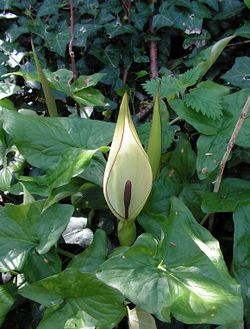Wild Arum
From Wikiwel
Other Names : Arum maculatum, Snakeshead, adder's root, arum, wild arum, arum lily, lords-and-ladies, devils and angels, cows and bulls, cuckoo-pint, Cuckoopint, soldiers diddies, priest's pintle, Adam and Eve, bobbins, naked girls, naked boys, starch-root, wake robin, friar's cowl, sonsie-give-us-your-hand, jack in the pulpit, cheese and toast.
Special Precautions of Wild Arum
- Arum maculatum is a poisonous plant and should be handled with care. Folklore often repeats tales of children who have died after eating the berries. The berries are the most toxic part of Arum maculatum and they can cause extreme discomfort if they are eaten. The juice from the berries will cause a burning sensation and medical advice should be sought if the berries are consumed.
- The root causes strong burning on the tongue and has a reddening and blistering appearance. It causes the most severe inflammation, especially of the mucous membranes. The irritating action of the fresh root is probably due to the glycosidic saponins, of which the plant contains up to 1 ‰ .
Health benefits and Uses of Wild Arum
Arum maculatum has a long history of medical use. Arum maculatum can help alleviate a range of different symptoms. The berries are highly toxic and should be avoided. The large tuberous root, however, has long been believed to have medicinal powers. The root is full of starch and has been used in many ways. Some of the medicinal uses of Arum maculatum include:
- Alleviate symptoms of sore throats - Arum maculatum is reported to help alleviate the symptoms of sore throats. It is taken as a homeopathic remedy and the tincture helps to reduce swollen membranes.
- Diuretic and stimulant - the root at one time was used as a diuretic and stimulant. It has dramatic and unpredictable results and this has meant that it is rarely used in this way now without supervision from a trained professional.
- For coughing, breast, lung and gastric mucus
- Externally as a healing agent and against plague bumps.
- Topically applied - an ointment or tincture from the root has been used to help alleviate symptoms of rheumatism. It is applied to the skin, however given the extreme toxicity of the plant, this should be done with great care and professional advice sought first.
- In homeopathy :
- Homoeopathic tincture is prepared from the plant, and its root, which proves curative in diluted doses for a chronic sore throat with swollen mucous membranes and hoarseness, and likewise for a feverish sore throat.
- for affections of the nervous system with convulsions and paralysis phenomena
- in chronic catarrh of the trachea and gastric mucosa with a tendency to hemorrhage, with bladder and loose easy
- bleeding gums.
- An ointment made by stewing the fresh sliced tuber with lard is stated to be an efficient cure for ringworm, though the fresh sliced tuber applied to the skin produces a blister.
- Juice of the fresh plant when incorporated with lard has also been applied locally in the treatment of ringworm.
